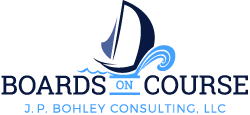Tip #59 Where Does the Board Fit in the Chain of Authority and Accountability
In our last Tip for Effective Boards, we began our review of the Ten Principles of the Policy Governance® model of board operations with a focus on the first principle of the model: Ownership. In this Tip for Effective Boards we turn to the second principle of the model: Board Position.
“Board Position: The board is accountable to owners that the organization is successful. As such it is not advisory to staff but an active link in the chain of command. All authority in the staff organization and in components of the board flows from the board.” (“Policy Governance® Source Document” produced by the International Policy Governance Association in consultation with John Carver and Miriam Carver, 2011: https://www.BoardsOnCourse.com/policy-governance.
This principle states that there is a hierarchical relationship between organizational ownership, board, CEO, and staff. Authority flows downward from ownership to board to CEO to staff while accountability flows upwards from staff to CEO to board to ownership. (As discussed in our previous Tip for Effective Boards, organizational ownership refers to those people who are shareholders in a publicly-traded corporation or for non-profit or public/governmental organizations, they are like shareholders in that they have an “interest” or “investment” in an organization’s purpose and success. They are those people on whose behalf the board governs and to whom it is accountable.)
So, the CEO is not the boss of the board. The board is not there to help the CEO and to be directed by the CEO. Rather, the board directs the CEO and holds the CEO accountable to it for the success of the organization. In addition, the board does not have a direct authority relationship with any employees other than the CEO who is held accountable by the board for all staff performance.
Understanding this hierarchical relationship of ownership, board, CEO, and staff provides important clarity of roles and relationships, important clarity about who directs whom and who is accountable to whom. Failure to recognize this structure can lead to frustration, confusion, conflict, and vulnerability to organizational disasters.
Perhaps this may seem straightforward and obvious. However, boards often act as if this clear hierarchical structure were not in place. Boards may act as if their CEO is their boss. They may act as if they are there to help the CEO and not to direct the CEO and to hold the CEO accountable. They may “rubberstamp” whatever the CEO recommends and not exercise their proper oversight role. In addition, they may bypass the CEO and provide board direction to staff who properly report to the CEO. They may micromanage operational details properly delegated to the CEO.
So, it’s a simple straightforward hierarchical structure. When it’s followed, there’s an organizational structure that provides clarity of critical roles and relationships, clarity of expectations, and a foundation for constructive relationships involving owners, board, CEO, and staff and for effective owner-accountable board governance.
For additional information about this principle, please check out Tips for Effective Boards # 4 (Clarify Roles of Board and Executive) and #29 (Four Steps to Being an Accountable Board): https://www.BoardsOnCourse.com/blog.
To see all ten principles of the Policy Governance® model, please click https://www.BoardsOnCourse.com/policy-governance and then click The Principles of Policy Governance® on the left-side menu.
